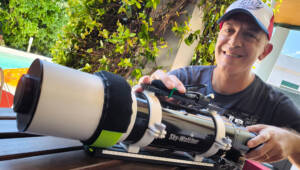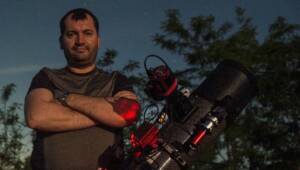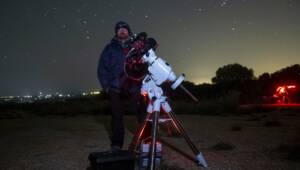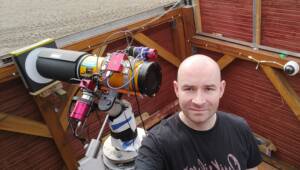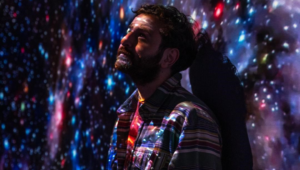Hello Lóránd, thanks for accepting our interview invitation. Congratulations on winning the ASIWEEK competition in week #24/2023!
Q1: At first, congratulation that your nice image won #ASIWEEK. Can you introduce yourself to us?
I started out as an amateur astronomer early in my teenage years. I was still living with my parents when I received my first telescope. This interest of mine accompanied me, though with changing intensity, until my early thirties, when I bought my first equipment for astrophotography. It was then that I realized that nature photography, which I had already come to expert, and the observation of space can be combined in one wonderful hobby. Maybe that’s enough about me, if you want to know more, you can find everything on my website (https://fenyeslorand.hu/en).

Q2: Why do you love astronomy? What does it mean to you?
This hobby has provided me with much appreciation in the last years, for which, of course, I am grateful. In the early years, every APOD appearance or for example the Astronomy Photographer of the Year competition award was exciting and motivating. However, I have come to see the value of competitions and accolades in general – in a different light. As of today, I find the excitement of working under the sky and the thrill of developing new photos more rewarding than any recognition for my results. And the personal aspect is that I do not regard the miracle of space as an end in itself. Moreover, in today’s increasingly alienating world, the magnificence of the night-time cosmos draws me close to nature. And it does so while at the same time making me re-evaluate my role because of the sheer size. The size of the ego, in sight of such a grand and pulsating universe, shrinks by comparison. And I think that is a very healthy effect…
Q3: What gear do you use for astrophotography? Any pictures of them?
I’ve come a long way in developing my astrophotography equipment. I started with a fairly simple telescope and tools, but now, working with a talent support foundation for many years, I have a great set of equipment that I’m naturally very happy with. Although a large f/7.8 apo is rarely used for deep sky photography, it seems to be a very good combination for me: thanks to the extremely sensitive modern CMOS mono cameras, an Astro-Physics Starfire 206EDF with outstanding imaging on a Fornax 150 is my main gear for both deep sky and planetary photography.

Q4: How many ZWO products do you have, what’s your first ASI camera?
This is interesting, because I have just started using ZWO products this year. The reason for this is that for many years I worked in beta tester cooperation with two other manufacturers, so I had a lot of cameras in my hands, no need to develop my own. I had a very simple need for ZWO: the integrated system provided by ASIAIR was a huge advantage for me. I had previously been working with rather old-fashioned tools and had not improved the convenience features of my home observatory. The capabilities that came with ASIAIR added a lot to the experience. I tried it, it convinced me and it marked my way. Of course, it also meant that I had to replace my cameras. So first, I started with a smaller model as a cautious step: the 533MM Pro with its filters which is my first ZWO camera, and the 120 mini that came with it is my first guide camera. I’m happy with them, all the pictures I’ve taken in the last few months have been taken with this setup. Because of the above, I am seriously considering replacing my other camera with a larger sensor with a product compatible with ASIAIR. But this is music for the future. It’s galaxy season now anyway. 🙂





Q5: How is the air quality in your region? Where do you normally take astrophotos?
I live in a very beautiful region of Hungary, next to the largest lake in Central Europe, on top of a small hill. Light pollution is not negligible because of the tourism due to the lake, but it is not unpleasant because of the hill top. I can work efficiently. The major cities in the region are to the west – northwest of us, so the most important parts of the sky are quite well visible.
Before that, I had taken part in several astrophotography expeditions, or even taken pictures on family holidays. So I took a number of pictures on the Namibian Savannah, some on islands in the Mediterranean, or even in the Alps.


Q6: Your ASIWEEK image “NGC 2841” was outstanding! How did you capture it?
Thank you for the honourable decision again. This was a simpler job, not even the main subject for this month, but the object photographed the rest of the time. It’s tiny, so with this combination (long focus of the apochromat + narrow FOV of the 533MM Pro), it’s an ideal subject. I caught good seeing, so the details come out properly. I thought it was important to have not only the main object, but also the background alive, so I worked with long exposures. The subtle little galaxies therefore emerged from the background glow of space.

Q7: How long do you normally spend on processing after date acquisition? What do you think is the most difficult part of processing for you?
As we all know, image processing is at least 50% of a finished photo, if not more. That’s true for me, too, and perhaps even more skewed. I spend a lot of time on the images, going over them detail by detail, to make sure that all the results are really right. I have developed many of my own processing techniques over the years, which I still use today, find these valuable because I can deviate a little from the trends and put my own stamp on the images. Of course, all this without compromising the authenticity of the image. The hardest part of the image processing for me is patience. 🙂 In many cases I have found that when I thought I was done with a photo, it was better to let it rest for a few days. Not even looking at it, so that my eyes “get used” to the subject. After all, if you spend a long time with a photo, you can get used to its flaws, so they remain uncorrected. For me, it is particularly difficult to impose this self-discipline on myself – but it always pays off.
Q8: How do you balance your work and hobby?
Fortunately, this is not a problem at all. I am at a stage in my life and I have a job where these two areas do not erode each other at all.
Q9: Does your family like to join you when you are taking astrophotos?
They are not involved in the work under the telescope, although they do visit me occasionally for sightings if I have a visiting group or if there is something in the sky that makes them want to come. Of course, I’m always happy to see them, but I don’t impose that on anyone. At the same time, they rejoice with me at the birth of each new picture, delighting in the result. They also attend my exhibitions, my presentations or the various social events. They know that this area of my life is important to me and we share the experience of it.
Q10: Is there anything you want to tell beginners?
Before taking up this hobby at the first sight of astrophotos, people should let it sink in that this kind of photography does not yield quick returns. You really must work hard to excel. One single photo takes many, many hours to produce, and you need to acquire a variety of skills before even beginning, which in turn takes patience, resolution, and even a kind of professional humility. This is a delightful activity, but it comes with a price – to be paid in advance. However, if you are willing to see astrophotography as a profound engagement for even a lifetime, letting go of the pace of today’s social sites, then you will not measure this activity by the 10 to 20 photos you take in a year. Then you will understand that this activity, with all the fiddling around under the dome of the sky, and with all the different phases of image processing, it is a very complex and at the same time a genuinely rewarding engagement. It slows you down compared to today’s standards, but that’s fine.
In addition, I strongly recommend assembling the first equipment only after thorough legwork and assessment. It takes a substantial investment, so there should be no rush, and the tools we buy are supposed to serve us for long years to come.
Q11: How do you think the future development of astrophotography? Do you think we will have more friends join us?
When I started this hobby, it was still a very layered activity. Today, this is no longer true, many people are getting into astrophotography. Of course it is good, helped by the increasing availability of products, the growing community, and the many well-understood documentations. However, far fewer people are ‘paying the real price’, getting to the point of putting truly remarkable work on the table. It is not something that can be bought. It is time and energy. In a way, I see the same process as I experienced back in the digital imaging boom. With the arrival of the first digital cameras and the subsequent wave of buyers, everyone started taking pictures. But it was only a narrower group of people who got to the point where they were able to do it with persistence and high quality. I think astrophotography is now surfing that wave. I think it’s our job to support newcomers, but also not to let the basic values get diluted.
Q12: What’s your impression of ZWO? Is there anywhere you think we can do better?
ZWO seems to me to be a very cleverly managed company, with a well-constructed bundling of different products that are built on top of each other. I do not see this as a disadvantage at all, in fact for me it is an advantage. As long as the quality of the products remains good, as long as quantity does not compromise quality, as long as the improvements and support give users a stable background, then the product line building is a smart concept and very welcome. Especially for those who value ready-made solutions – like me.



